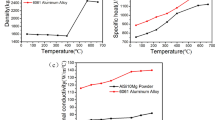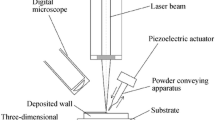Abstract
Laser cladding, as a promising manufacturing technology, has been widely used in industry for component recovery and surface modification. In this paper, a hollow laser beam was proposed to optimize the laser intensity distribution. A three-dimensional (3-D) finite element (FE) model was developed using ANSYS to investigate the thermal field in the clad deposited by a hollow laser beam. The thermal results, such as the temperature distribution and the cooling rate, were investigated. The effect of the hollow ratio between the inner and outer radius of the hollow beam on the molten pool shape was also studied. The temperature at the boundary of the molten pool was higher than at the center. A clad with a flat metallurgical bonding was formed. The microstructure in the clad was mainly consisted of fine dendrites except the large columnar structures along the bonding. The hardness distribution of the clad was associated with the grain size distribution and the dilution by the substrate. The molten pool was not able to be generated with a high hollow ratio, while overheated at the center with a low hollow ratio. Based on the comparison with the Gaussian laser beam, the hollow laser beam could effectively alleviate the overheating at the center of the clad.
Similar content being viewed by others
References
Toyserkani E, Corbin S, Khajepour A (2005) Laser cladding. CRC, Canada
Lowney M (2000) Nozzle particularly suited to direct metal deposition, United States, US Patent # 6,534,745
Lange D, Hofman J, Meijer J (2005) Influence of intensity distribution on the melt pool and clad shape for laser cladding. Proceedings of the Third International WLT-Conference on Lasers in Manufacturing, Munich
Fabbro R, Peyre P, Berthe L, Scherpereel X (1998) Physics and applications of laser-shock processing. J Las Appl 10(6):265–280
Chilamakuri S, Bhushan B (1999) Contact analysis of laser textured disks in magnetic head-disk interface. Wear 230:11–23
Wang Y, Yang X, Liu Y (2006) Temperature field of laser scanning line facula. Chin J: Chin J Las 33(7):981–986
Demirci E, Nolke C, Kaierle S, Matteazzi P (2012) Development of a hollow laser beam for micromachining. Adv Opt Tech 1(5):365–370
Shi S and Fu G (2006) A laser cladding process with various laser spot sizes and its corresponding laser head configuration, China, CN Patent #200610024264.6
Shao Q (2008) Study on the technology of inside-laser coaxial powder feeding cladding and rapid prototyping process of laser. Ph.D. Thesis, Soochow University
Shi G, Shi S, Zhang J (2012) The influence of defocusing amount of hollow beam on the quality of single clad. Chin J : Appl Las 32(6):505–509
Li H, Shi S, Fu G, Wang Y, Cai Q, Wang C, Sun H (2011) Control of process parameters of reducing solid of revolution with coaxial inside-beam powder feeding deposition. Chin J: Chin J Las 38(8):3012–3024
Li C, Shi S, Liu S, Cai Q (2009) Roller repairing with intern coaxial wire feeding laser cladding. Chin J Hot Working Tech 38(18):3814–3819
Shi S, Fu G, Li L, Wang Y (2010) Realization and research of laser cladding with method of internal wire feeding through a hollow laser beam. Chin J: Chin J Las 1:266–270
Shi S, Wang C, Xu A, Sun H, Li H (2012) Temperature field numerical simulation of laser cladding based on internal powder feeding through a hollow laser beam. Chin J: Chin J Las 39(3):56–62
Chin R (1998) Thermomechanical modeling of residual stresses in layered manufacturing with metals. Ph.D.Thesis, Carnegie Mellon University
Deus A, Mazumder J (1996) Two-dimensional thermo-mechanical finite element model for laser manufacturing. International Congress on Applications of Lasers & Electro-Optics (Proc. ICALEO) 174–183
Labudovic M, Hu D, Kovacevic R (2003) A three dimensional model for direct laser metal powder deposition and rapid prototyping. J Mater Sci 38:35–49
Suarez A, Amado J, Tobar M, Yanez A, Fraga E, Peel M (2010) Study of residual stresses generated inside laser cladded plates using FEM and diffraction of synchrotron radiation. Surf Coat Tech 204:1983–1988
Alimardani M (2009) Multi-physics analysis of laser solid freeform fabrication. Ph.D. Thesis, Univeristy of Waterloo
Li C (2010) Modeling for transmission and conversion of hollow circular laser and analysis on coupling between laser and materials in three-dimensional laser manufacturing. Ph.D. Thesis, Soochow University
Ansys 11.0, Structure and Thermal analysis
Dantzig J, Rappaz M (2009) Solidification methods microstructure and modeling, EPFL Press
Author information
Authors and Affiliations
Corresponding author
Appendix
Appendix
A cylindrical laser beam with the intensity I0 irradiates a 45° mirror and is reflected onto a parabolic ring mirror, forming a hollow laser beam which is symmetrical to the focal plane, as shown in Fig. 3a. The laser beam profile is characterized by two parts: one is the straight propagation part of the laser (regions I and V) and the other is the Rayleigh range (regions II, III, and IV) when the laser beam is close to the focal point. In the Rayleigh range, the laser beam can be subdivided into two sections: one without intersections of the laser beam (regions II and IV) and one with intersections of laser beam (region III) [20].
In the straight propagation part (regions I and V), the distribution of the laser intensity I is written as [20]
where \( r\in \left(\frac{p^2-{\left(H-\frac{d}{2}\right)}^2}{2p\left(H-\frac{d}{2}\right)}|h\left|,\frac{D}{2H}|h\right|\right),\kern0.5em {a}_1=\frac{p\left(r+\sqrt{r^2+{h}^2}\right)}{\left|h\right|} \), p is the characteristic parameter of the parabolic mirror, h is the axis distance, H 1 is the Rayleigh length, and H 2 is the intersection length.
In the Rayleigh region without intersections of laser beam (regions ІІ and IV), the distribution of laser intensity I yields as described in [20]
where \( r\in \left(-\frac{d_{\min }}{2}+\frac{\left({H}_1D+H{d}_{\min}\right)\left|h\right|}{2H{H}_1},\frac{d_{\min }}{2}+\frac{\left[{H}_1\left({p}^2-{\left(H\hbox{--} \frac{d}{2}\right)}^2\right)-p\left(H\hbox{--} \frac{d}{2}\right){d}_{\min}\right]\left|h\right|}{2p\left(H\hbox{--} \frac{d}{2}\right){H}_1}\right),\kern0.5em {a}_1=\frac{p\left({b}_1+\sqrt{b_1^2+{H}_1^2}\right)}{\left|{H}_1\right|},\kern0.75em {b}_1=\frac{\sqrt{2}{H}_1r+\left(\frac{\sqrt{2}}{2}{d}_{\min }+\frac{D}{2H}{H}_1\right)\left(\left|h\right|-{H}_1\right)}{\left(\sqrt{2}-1\right)\left|h\right|+{H}_1} \)
In the Rayleigh region with intersections of laser beam (region III), the distribution of laser intensity I of the nonintersection part and intersection part are described as [20]
where
Rights and permissions
About this article
Cite this article
Liu, S., Kong, F., Shi, S. et al. Study of a hollow laser beam for cladding. Int J Adv Manuf Technol 73, 147–159 (2014). https://doi.org/10.1007/s00170-014-5763-1
Received:
Accepted:
Published:
Issue Date:
DOI: https://doi.org/10.1007/s00170-014-5763-1




